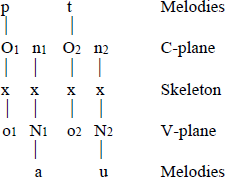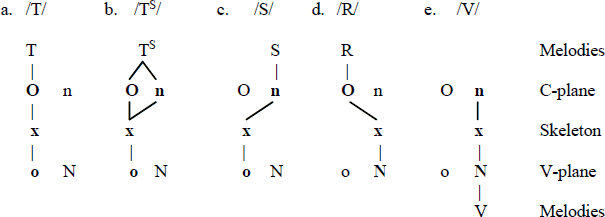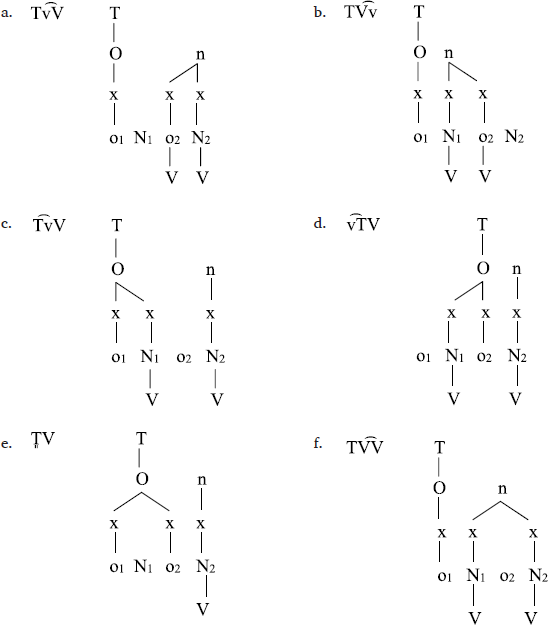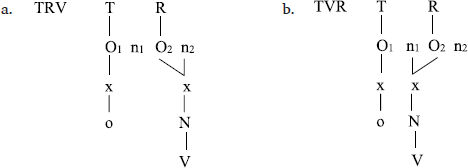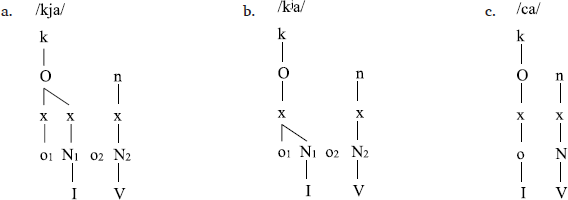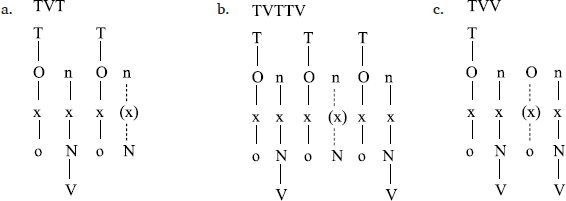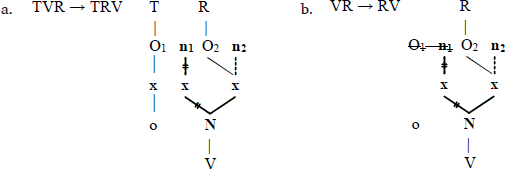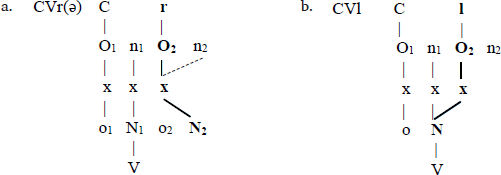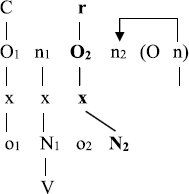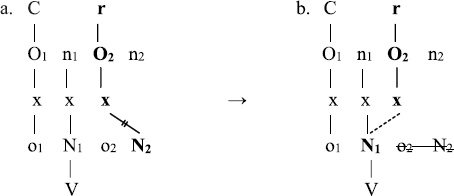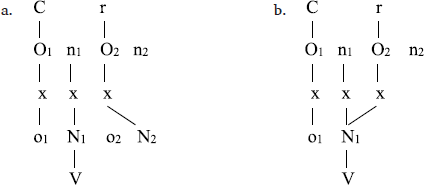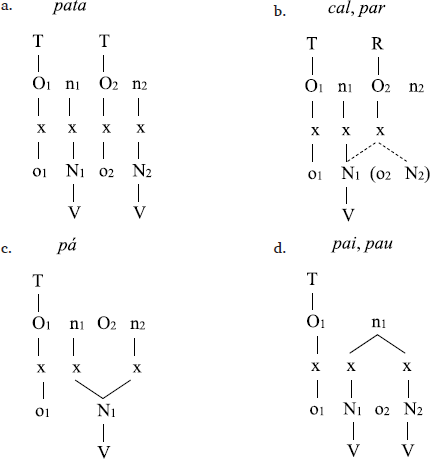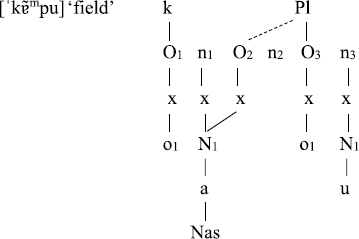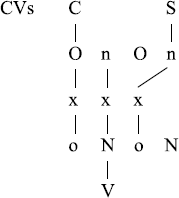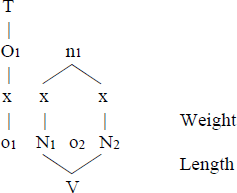1 Introduction
Portuguese has been claimed to have a weight-based stress placement rule, even if, contrary to what happens in Latin for example, stress is contrastive. There are, indeed, several strong arguments that support this claim. However, the issue remains controversial. One problem is still unsolved before the Weight-based Theory of stress placement (henceforth WBT) can be said to rest on firm foundations: the oxytonic words ending with open syllables do not apparently square with the theory. These oxytones could be explained by the WBT if their final vowels were independently shown to be heavy without being long, as there is no phonemic length in Portuguese; otherwise, such a claim would be circular. It will be seen that the paradoxical behaviour vis-à-vis vowel reduction of what I will call “/Vr/-rhymes” for the sake of convenience provides the necessary independent evidence in the European variety, but on one condition: the treatment of these syllables requires a model where sonority categories like plosives, affricates, fricatives, liquids, glides etc. follow from structure, not from features. Assuming such a framework, we will have killed two birds with one stone: the “misbehaviour” of /Vr/-rhymes will be explained, and weight and length will be disentangled, the WBT being established on solid grounds.
The article is organized as follows. In Section 2, I will summarize the claim that Portuguese has relevant syllable weight and weight-sensitive stress placement; I will also list and comment the several objections that have been raised against the WBT, so as to keep only two of them: vowel-final oxytones and “short heavy” vowels. In Section 3, I will first describe the challenge presented by EP /Vr/-rhymes, and why the current theories are unable to offer a satisfactory account. The theory of phonological representations that should account for this problem will then be introduced in Section 4, and applied to the issue of /Vr/-rhymes in Section 5. I conclude by showing, in Section 6, how this proposal assigns different representations to weight and length, in such a way that long vowels are necessarily heavy, but heavy vowels are not necessarily long, length and weight being based on different facets of phonological representations.
2 The case for syllable weight in Portuguese
Stress in Portuguese is contrastive, given that words with identical segmental content can have different stress patterns while having different meanings. Minimal pairs like [ˈsu.pli.kɐ] ‘supplication’ ~ [su.ˈpli.kɐ] ‘beg3sg.pres’ show this difference between antepenultimate stress in the former case and penultimate stress in the latter; likewise, pairs like [ˈka.ɾɐ] ‘face’ ~ [ka.ˈɾa] ‘yam’ show penultimate and final stress, respectively. These examples illustrate the three patterns attested in European and Brazilian Portuguese (henceforth EP and BP), where words may be proparoxytones, paroxytones or oxytones. The distribution of stress can thus be said to be unpredictable, so that stress in Portuguese must be lexically encoded. However, although lexically codified information is definitely necessary for cases in which stress is contrastive or unpredictable, stress assignment in Portuguese is not completely free.
Most scholars agree that the default stress pattern in Portuguese, at least in non-verbs, is predicted by way of a moraic trochee located at the right edge of the prosodic word. The typical generalization can be formulated as in (1), and is shared by Carvalho (1989) and Wetzels (2007) for EP and BP respectively. Interestingly, this view, based on a generative background, is also partly supported by Garcia (2017; 2019) and Garcia & Goad (2021), who propose a probabilistic approach to stress. Light and heavy syllables are defined in (2).
- (1)
- Stress falls on the word-final syllable, if heavy; otherwise it is on the penultimate syllable.
- (2)
- a.
- Light syllables have /V/- and /Vs/-rhymes.
- b.
- Heavy syllables have diphthongs, nasal nuclei, /Vl/- and /Vr/-rhymes.
The patterns that obey the generalization in (1) fall into two categories that are exemplified in (3a,b) for nouns and verbs: paroxytones with final light syllables, and oxytones with final heavy syllables. These patterns contrast with those under (4a,b) respectively.
- (3)
- Unmarked patterns
- a.
- Paroxytones with final light syllables
- mata
- matas
- ‘forest’
- ‘forestpl’
- mata
- matas
- ‘kill3sg.pres’
- ‘kill2sg.pres’
- b.
- Oxytones with final heavy syllables
- calhau
- cação
- animal
- colar
- ‘rock’
- ‘sandbar shark’
- ‘animal’
- ‘necklace’
- cantei
- farão
- –
- colar
- ‘sing1sg.perf’
- ‘make3pl.fut’
- ‘pastinf’
- (4)
- Marked patterns
- a.
- Proparoxytones
- cântaro
- cântaros
- ‘pitcher’
- ‘pitcherpl’
- cantávamo (BP)
- cantávamos
- ‘sing1pl.imperf’
- ‘sing1pl.imperf’
- b.
- Paroxytones with final heavy syllables
- possíveis
- sótão
- Setúbal
- âmbar
- ‘possiblepl’
- ‘attic’
- toponym
- ‘amber’
- cantáveis
- cantam
- –
- –
- ‘sing2pl.imperf’
- ‘sing3pl.pres’
At least four arguments come to comfort the WBT. First the statistical data. Table 1, based on the variety of the State of São Paulo (Brazil), shows the distribution of Portuguese words according to their stress pattern and the nature of their last syllable.
Frequency of stress patterns in Portuguese.
| Stress patterns | Final heavy syllable | Final light syllable | ||
| Oxytones | 32 255 | 21,38% | 5 336 | 3,54% |
| Paroxytones | 4 431 | 2,94% | 89 894 | 59,58% |
| Proparoxytones | 182 | 0,12% | 18 231 | 12,08% |
| Monosyllables | 370 | 0,25% | 176 | 0,12% |
| Total | 37 238 | 24,68% | 113 637 | 75,32% |
That is: 80.96% of the lexicon follows the stress patterns defined as unmarked in (3), whose percentage values are in bold in Table 1. From the data provided by the Houaiss dictionary of Portuguese, Garcia (2017) gives ≈ 72%, leaving aside monosyllables.
Secondly, the variation that affects stress patterns, particularly in registers further away from the norm, supports the WBT: cf. Carvalho (2015) and, for proparoxytones, Pimenta (2019: 25–26). The changes they reveal are always unidirectional: through the most varied means (syncope, monophthongization, denasalization, metathesis, palatalization and even – a very rare phenomenon – displacement of stress), it is the marked pattern that becomes unmarked, as can be seen in (5); never, as far as I know, does the reverse process take place.
- (5)
- cântaro > cantro
- fáceis > faces
- homem > home
- cadáver > cadavre
- tábua > tauba
- família > fami[ʎ]a
- pêssego > pesgo, pessego
- ‘pitcher’
- ‘easypl’
- ‘man’
- ‘corpse’
- ‘board’
- ‘family’
- ‘peach’
Thirdly, there are active restrictions in Portuguese that demonstrate the heavy character of the rhymes /VV/, /VN/, /Vl/ and /Vr/, which cannot occur in the penultimate syllable of proparoxytones: words like *cânteiro, *cágaldo or *abóbarda are impossible in Portuguese.1
Finally, in EP, an interesting correlation can be seen between the syllable weight defined by the WBT and the propensity of the vowel to undergo vowel reduction in unstressed syllables: vowels in light syllables (6a) undergo vowel reduction, those in heavy syllables (6b-f) do not.
- (6)
- a.
- ch[e]go ~ ch[ə]gar
- s[ɛ]co ~ s[ə]car
- b[a]to ~ b[ɐ]ter
- v[ɔ]to ~ v[u]tar
- c[o]zo ~ c[u]zer
- ‘arrive1sg.pres~inf’
- ‘dryisg.pres~inf’
- ‘hitisg.pres~inf’
- ‘voteisg.pres~inf’
- ‘cookisg.pres~inf’
- b.
- d[ei̯]to ~ d[ei̯]tar
- p[ai̯]ro ~ p[ai̯]rar
- p[au̯]to ~ p[au̯]tar
- aç[oi̯]to ~ aç[oi̯]tar
- ‘throwisg.pres~inf’
- ‘soarisg.pres~inf’
- ‘directisg.pres~inf’
- ‘whipisg.pres~inf’
- c.
- t[ẽ]nto ~ t[ẽ]ntar
- m[õ]nto ~ m[õ]ntar
- ‘tryisg.pres~inf’
- ‘rideisg.pres~inf’
- d.
- r[ɛ]lva ~ r[ɛ]lvado
- s[a]lto ~ s[a]ltar
- s[ɔ]lto ~ s[ɔ]ltar
- ‘grass’ ~ ‘lawn’
- ‘jumpisg.pres~inf’
- ‘untieisg.pres~inf’
- e.
- móv[ɛ]l
- Setúb[a]l
- álc[ɔ]l
- ‘piece of furniture’
- (toponym)
- ‘alcohol’
- f.
- cadáv[ɛ]r
- açúc[a]r
- Vít[ɔ]r
- ‘corpse’
- ‘sugar’
- ‘Victor’
As Lüdtke (1953) had already noted, vowel reduction has a quantitative basis in EP, as can be seen from the so-called crasis, in which the unstressed sequence [ɐ]+[ɐ] produces [a]. It should be noted that this constitutes an active and post-lexical process in the language, as shown in (7).
- (7)
- [ɐ] + [ɐ] cidade
- [ɐ] + [ɐ]miga
- pag[ɐ] + [ɐ]
- cas[ɐ] + [ɐ]zul
- er[ɐ] + [ɐ]gradável
- →
- →
- →
- →
- →
- [a] cidade
- [a]miga
- pag[a]
- cas[a]zul
- er[a]gradável
- ‘to the city’
- ‘the friendfem’
- ‘payisg.pres her’
- ‘blue house’
- ‘be plesant1,3sg.imp’
Notwithstanding statistical evidence, the phonetic changes in (5), and the constraints on proparoxytones, divergent opinions have been expressed, especially among specialists of EP. Some scholars (e.g. Mateus 1982; Mateus & Andrade 2000; Pereira 1999; 2007; Vigário 2003) reject quantitative accounts of stress placement, and propose a morphology-based analysis. They raise five main arguments against the WBT.
First, as outlined above, stress is contrastive in Portuguese (e.g. sábia ‘wisef’, sabiá ‘song-thrush’, sabia ‘know1/3sg.imp’), which is seen as crucial counterevidence for the generalization in (1). However, the WBT does not deny that Portuguese stress is, to some extent, unpredictable. It is therefore not comparable to the fixed stress of Latin, Classical Arabic or Polish. But neither is it similar to that of Russian, whose placement obeys an extremely complex morphology-based algorithm. What the WBT assumes is a stress pattern by default.
Secondly, even if stress placement is relatively predictable by way of syllable weight in nouns, it is largely controlled by morphology in verbs, which is likely to suggest the unwelcome idea that two phonologies – weight-based for non-verbs, morphology-based for verbs – coexist in Portuguese. However, in making this observation, adherents of a morphological theory seem to miss one point: the distribution of marked and unmarked stress patterns in both nouns and verbs has a semantic correlate. Although we lack a detailed analysis, it does not seem too risky to venture that the cultured, technical and infrequent part of the nominal lexicon is overrepresented in proparoxytones and in paroxytones with a heavy final syllable. In verbs, marked stress patterns are associated with morphological markedness (Carvalho 2003; 2015), as shown in (8), assuming that the plural is marked with respect to the singular (8a), that the imperfect or the pluperfect are marked in relation to the present (8b), and that the conditional is marked with respect to the future (8c). The stressed syllable is underlined.
- (8)
- Marked patterns (= (4a,b)) Unmarked pattern (= (3a))
- a.
- b.
- c.
- cantam, cantavam
- cantassem
- cantávamos
- cantávamos, cantáramos
- cantássemos
- cantaríamos
- ‘sing3pl.pres,imperf’
- ‘sing3pl.imperf.subj’
- ‘sing1pl.imperf’
- ‘sing1pl.imperf,plup’
- ‘sing1pl.imperf.subj’
- ‘sing1pl.cond’
- canta, cantava
- cantasse
- (eu) cantava
- cantamos
- cantemos
- cantaremos
- ‘sing3sg.pres,imperf’
- ‘sing3sg.imperf.subj’
- ‘sing1sg.imperf’
- ‘sing1pl.pres’
- ‘sing1pl.pres.subj’
- ‘sing1pl.fut’
Thirdly, the extrametricality of the final /s/ in (2a, 3a) is apparently contradicted by many oxytonic words, where this phoneme is often written with <z> for etymological reasons (e.g. rapaz ‘boy’, cortês ‘polite’, nariz ‘nose’, veloz ‘fast’, avestruz ‘ostrich’). I will not dwell on that issue, but this problem can be solved either through a one-step process, assuming that the two /s/ are associated to different structures, or within a stratal model of phonology, the extrametrical /s/ being a (3rd person or plural) suffix (cf. on this topic Carvalho 2022).
Fourthly, there is no phonemic vowel length in Portuguese, which may seem odd in a weight-sensitive language. This critique raises the following issue: is the bimoraicity of nuclei necessarily realized through length? After all, weight is a property of syllables; by contrast, length, wherever it exists, is primarily an intrinsic contrastive property of vowels (or consonants). At any rate, the data exposed in (7) show that the unstressed [a] of EP realizes two underlying vowels, even if, in relation to [ɐ], this [a] does not exceed the intrinsic duration of an open vowel. It follows from this that syllable weight may also be manifested through vowel quality.
The relationship between weight and vowel quality is closely linked to the last criticism of WBT, which is the following: Portuguese has many oxytones ending with putative light /V(s)/-rhymes (e.g. sofá ‘sofa’, café ‘coffee’, caju ‘cashew nut’, cipó ‘vine’, avô ‘grandfather’, comi ‘I ate’). Such words represent 3,54% of the lexicon analyzed by Viaro & Guimarães-Filho (2007) (cf. Table 1), but could hardly be viewed as marked. They include, in BP, many terms borrowed from Tupi and Yoruba, oxytones with final open syllables being particularly frequent in these loans. This issue and the preceding one constitute a real problem. Any solution based on the WBT is obliged to consider the final syllables of these oxytones as heavy, and to answer the question that arose from the previous criticism: how can the final vowel of these syllables be heavy without being long?
3 The problem
Assuming that Portuguese is a weight-sensitive language, /Vr/-rhymes show a paradoxical behaviour in the European variety, as explained in (9).
- (9)
- a.
- On the one hand, pretonic /Vr/-rhymes undergo vowel reduction, like light syllables (/V(s)/):
- cf. for instance c[ɐ]rtola ‘top hat’, v[ə]rter ‘pourinf’, m[u]rder ‘biteinf’
- ≠ s[a]ltar ‘jumpinf’, b[ɛ]ldade ‘beauty’, s[ɔ]ldado ‘soldier’.
- b.
- On the other hand, final /Vr/-rhymes generally attract stress, while avoiding vowel reduction when they don’t, like heavy syllables (/Vv, Vl, VN/):
- cf. açúc[a]r ‘sugar’, cadáv[ɛ]r ‘corpse’, Vít[ɔ]r ‘Victor’
- = Setúb[a]l ‘name of a town’, móv[ɛ]l ‘piece of furniture’, álc[ɔ]l ‘alcohol’.
Why so? Interestingly, it can be argued that the forms with full vowels like açúc[a]r or cadáv[ɛ]r are underlyingly proparoxytonic since they emerge as such in the plural, as shown in (10). That the plural suffix is [-s], not [-əs], is supported (a) by the entire Portuguese lexicon, as nouns ending in [-əs] in the plural retain the schwa in the singular (e.g. pot[ə](s) ‘pot’), (b) by the fact that açú[kɐɾə] and cadá[vəɾə] are possible, albeit non-standard, singular forms.
- (10)
- açú/kɐrə (+ s)/
- cadá/vəɾə (+ s)/
- →
- →
- açú[kaɾ], açú[kɐɾə]s
- cadá[vɛɾ], cadá[vəɾə]s
This singular/plural alternation concurs with crasis seen in (7) in supporting an analysis according to which two unstressed syllables containing reduced vowels are worth one syllable containing a full vowel in terms of weight. The final vowel could then be said to be deleted losing its mora, which associates with the preceding vowel, as shown in (11); becoming heavy, the latter escapes vowel reduction.
- (11)
However, (i) the process in (11) remains arbitrary, as nothing explains why only /r/, and not /l/ nor any other consonant, is concerned; (ii) the resulting vowel is not long, if length is expected to be a necessary correlate of bimoraic vowels.
These two points are the core elements of my contribution to the problem of context-dependent weight within a single language. Rosenthall & Van der Hulst’s (1999: 500) optimality-theoretic account of such issues has clearly argued that either “closed syllables are light, but contextually heavy to satisfy some higher ranking constraint [or] closed syllables are heavy, but contextually light to satisfy some higher ranking constraint.” As will be seen in Section 5, something similar happens with the variable vowel weight of EP /Vr/-rhymes. However, we still have to explain why only those syllables are concerned and why vowel length is not involved in the process. These issues require additional representational tools.
4 The C/V Alignment Theory
It will be shown that the paradoxical behaviour of EP /Vr/-rhymes can be accounted for by Carvalho’s (2017) Strict CV-based approach to phonological representations. Let us call it the C/V Alignment Theory of Sonority (henceforth AT), which combines the features under (12).
- (12)
- a.
- Consonants and vowels are universally segregated,
- b.
- and involve two parallel ONON sequences, on the C-plane and on the V-plane,
- c.
- which are variably synchronized across an x-skeleton, different C/V alignments giving rise to the several sonority-based categories (plosives, fricatives, liquids, glides etc.),
- d.
- and, crucially, may differ in length.
C/V segregation is supposed to be much more than a particular characteristic of Semitic morphology; morphology simply exploits what phonology provides. From acoustic (Öhman 1966), articulatory (Fujimura 1992), acquisitional (McDonough & Myers 1991; Macken 1992) and cognitive (Obleser et al. 2010) data, a large body of evidence supports the view that consonants and vowels belong to separate channels in the speech ‘plan’, but must interact through implementation in the same vocal tract.
The periodic ONON…ON sequence is based on what constitutes the foundation of Strict CV (Lowenstamm 1996; Scheer 2004), whose earlier version, classic Government Phonology (Kaye et al. 1990), distinguished between the sequence of syllable constituents and the skeleton made of x-slots (Vergnaud 1982; Levin 1983).
Given (12a,b), a word like Port. /ˈpatu/ pato ‘duck’ will be assigned the representation under (13), where O and n stand for the onset and the nucleus in the C-plane, and o and N represent the same entities in the V-plane.
- (13)
Two important features of AT are the ones mentioned in (12c) and (12d). It follows from the former that the skeleton is the locus through which the C- and the V-planes interact in such a way that several alignments are allowed. As shown in (14), these C/V alignments (in bold) define various sonority categories according to which elements of the two planes are synchronized. Four consonantal categories are represented in (14a-d): T = plosive, TS = affricate, S = fricative, R = sonorant, V being a vowel.2
- (14)
Moreover, this framework allows an interesting explanation of the complex and ambiguous behaviour of nasal consonants, which would deserve an article of their own. Consonantal nasality is a melody that will be assumed to associate with the onsets of the C-plane. Nasal consonants therefore behave sometimes as obstruents (T = O-o alignment) as in (14a), sometimes as sonorants (R = O-N alignment) as in (14d), especially in the coda (where, like the other sonorant consonants, it is generally unspecified as to place).
It follows from (12d) that the theory generates, for example, twelve syllable types according to which plane is longer than the other: in (15) the C-plane is twice as long as the V-plane, while (16) shows the opposite case.3
- (15)
- (16)
As for the structures where the C-plane is longer than the V-plane, (15a) represents clusters of the type muta cum liquida. (15b) underlies sonorant codas (including nasals). Onsets such as Greek ps, ks involve (15c), while (15d) represents sp, st, sk clusters as those of English. The structure in (15e) can be found in the “harmonic” clusters of Georgian (/pk, tk…/) and Greek or Margi (/pt, kt/), as well as in long consonants if the two Os share the same melody, e.g. in Swiss German (Kraehenmann 2001).4 The structure in (15f) will be discussed in Section 6.
As to the configurations where the V-plane is longer than the C-plane, (16a) involves light rising diphthongs as in French [bwa] bois ‘wood’, [bɥi] buis ‘boxwood’, while (16b) represent light falling diphthongs, like Old English io, eo, ea. Heavy rising diphthongs, as in Italian piede ‘foot’, imply (16c)-like structures. As to (16d), it underlies glide+C clusters: cf. Polish łba ‘skullgen’. The structure in (16e) can be found in the so-called “fortis” or “tense” consonants of Korean (Ahn & Iverson 2004). Finally, (16f) is that of heavy falling diphthongs (e.g. English pie, Portuguese pai ‘father’) and long vowels if the two Ns share the same melody.
Importantly for the present topic, the above representations suggest a formal definition of the so-called “mora”. The R-bearing O in (15a,b) has an x-slot of its own (associated to N as well). However, nothing prevents it from sharing its slot with N, as shown under (17). Within this model, linearity results from the sequence of alignments, not directly from the skeleton: thus, in (17a), R = O2-N still precedes V = n2-N, and, in (17b), V = n1-N precedes R = O2-N.
- (17)
I propose that a mora is the association of a nucleus of the V-plane to an x-slot, that is an N-x link. Hence, (17a,b) are monomoraic, while (15a,b) are bimoraic, as they involve a bipositional N. Note that (15a) can be illustrated by the well-known moraic /TR/-onsets of Samothraki Greek analyzed by Topintzi (2010: 102 ff.).
Moreover, while the difference between 2-slot and 3-slot structures is associated to weight when N is concerned, it also manifests itself, albeit differently, in the remaining structures. Let us consider for example (16c) T͡vV. As shown in (18) (where /k/ stands for [dorsal]), the number of slots maps, say, different degrees of phonologization: with three slots, /kjV/ in (18a) can be said to involve a cluster and three phonemes, while the 2-slot structure in (18b) shows a dorsal consonant with a palatal secondary articulation like those that can be found in languages having a set of such consonants, e.g. Russian. For comparison, with two planes of equal length, (18c) represents a dorso-palatal consonant, assuming that I and U are intrinsically vocalic elements.
- (18)
- a.
Only (15e,f) and (16e,f) may necessarily have 3 slots, assuming that no x can be linked to two onsets or two nuclei in the same plane. This constraint requires further research.
Why are such structures needed? I will give two answers to this question. The first follows from the comparison of (15, 16) with (19), where the C- and V-planes have equal length.
- (19)
Note that unassociated Os or Ns in this framework are simply zero; they are phonologically inert. But associated Os or Ns do have phonological effects: for example, an underspecified [ʔ] in the first case, moraicity in the second case. The representations in (19) cover the two cases, hence the bracketed slots and the dotted lines.
Structures like (19a,b) are common in languages that lack significant phonotactic constraints (e.g. Arabic). It follows from the periodic ONON sequence assumed in (12b) that a plosive coda requires an empty N in the V-plane at its right, unlike the sonorant coda in (15b). Interestingly, that plosive codas entail greater complexity is supported by the fact that codas are preferably sonorants cross-linguistically (Hyman 1985). Also, as they involve a following N, plosive codas have stronger propensity to trigger vowel epenthesis: cf. Brazilian Portuguese [ˈbɐɡi] ‘bug’, [ˈapitu] apto ‘able’ vs. [ˈkaɾtɐ] carta ‘letter’. Note that (19b) can also represent (plosive) geminates if the two Os share the same melodic content (T), and that, in (19a,b), coda moraicity, if any, emerges from association of the empty N. With regard to the configuration in (19c), it will be assumed that it represents hiatuses, as opposed to the several diphthongs in (16).
My second argument is based on processual evidence. Within AT, many processes turn out to depend on C/V synchronization. Let us consider, for example, the well-known propensity of liquids to undergo metathesis cross-linguistically, as in the changes whereby Latin turbulare, formaticum, berbicem gave French troubler ‘troubleinf’, fromage ‘cheese’, brebis ‘sheep’. As shown in (20a), R does not move in TVR > TRV. Metathesis depends on the N-n alignment (in bold), N ending up aligned with n2, and is favoured (i) by plane asymmetry whereby V has two possible alignments in both TVR and TRV but crucially not in (19a) TVT; and (ii) by structure preservation, which is why VR does not give RV (cf. Latin arca > French arche ‘arch’, not *rache); otherwise, O1n1 would be deleted, as shown in (20b).
- (20)
5 Why are /Vr/-rhymes context-dependent?
Let us return to the problem of /Vr/-rhymes described in Section 3. We need to answer the two questions in (21).
- (21)
- a.
- Why do internal /Vr/-rhymes undergo vowel reduction, unlike /Vl/-rhymes?
- b.
- Why do final /Vr/-rhymes avoid vowel reduction, like /Vl/-rhymes?
Let us first assume that EP /Vr/- and /Vl/-rhymes involve, within the AT, the underlying representations in (22a) and (22b) respectively, only the latter being a “C/V-gap” structure.
- (22)
If the mora corresponds to an N-x link (cf. Section 4), then both structures in (22) are heavy as they display two N-x links. Hence, both attract stress according to the WBT (cf. Section 2). However, /Vr/- and /Vl/-rhymes differ in two respects. First, through n2-N2 alignment, the underlying representation in (22a) surfaces in plural forms as [maɾə]s ‘seas’, [koɾə]s ‘colours’, and, in unstressed position, as açú[kɐɾə]s ‘sugars’, cadá[vəɾə]s ‘corpses’, which undergo vowel reduction since N1 is associated with only one slot. By contrast, words like [sɑɫ] ‘salt’ or mó[vɛɫ] ‘piece of furniture’ cannot allow plural forms such as *[salə]s or *mó[vələ]s, since (22b) lacks a second N in the V-plane. (Instead, we have sais, móveis, which come from a very old deletion of intervocalic l, and are no longer phonologically derivable in the modern language.)
Secondly, word-final /Vr/ often triggers epenthesis (mar[ə], mar[i], açúc[ɐ]r[ə]) mostly in non-standard varieties, hence (i) the N2 in (22a), with O2 being aligned with N2, not with N1, and (ii) possible n2-association in (22a) entailing epenthesis through n2-N2 alignment. By contrast, /Vl/ shows strong interaction between the two segments, which manifests as /Vl/-velarization (plus /l/-vocalization in BP): mal [mɑɫ] ‘badly’, mel [mɛ̰ɫ] ‘honey’, mil [mḭɫ] ‘thousand’ etc. This is reflected by the bipositional N in (22b), which remains unchanged in both internal and final positions, and, being heavy, protects /Vl/ from vowel reduction.
Why, then, do internal /Vr/-rhymes undergo vowel reduction? As shown in (23), as it has two N-x links, /Vr/ is, indeed, heavy, although there is no vowel epenthesis, i.e. no n2-N2 alignment, since n2 is properly governed by the nucleus of the following syllable. But, being associated with only one slot, N1 in (23) is light, and thus undergoes vowel reduction if unstressed.
- (23)
As to why final /Vr/-rhymes avoid vowel reduction, it should be pointed out that schwas are generally deleted in standard EP, especially word-finally: cf. [ɑɫˈfasə] → [ɑɫˈfas] alface ‘lettuce’, [ˈpei̯ʃə] → [ˈpei̯ʃ] peixe ‘fish’ etc. As schwas correspond to empty nuclei in the V-plane, EP will be assumed to ban association of final empty Ns to the skeleton. Hence forms like açú[kaɾ] where, since the empty N2 is delinked, as in (24a), the /r/-bearing O2 is obliged to align with N1, as in (24b). Otherwise, /r/ would also be deleted: remember that R is an O-N alignment!5 Being associated with two slots, as in /Vl/-rhymes (cf. 22b), N1 in (24b) is heavy, and thus avoids vowel reduction if unstressed.6
- (24)
Hence, only light syllables with reduced vowels like [Cɐɾ, Cəɾ, Cuɾ] if unstressed are allowed in (23), and only heavy syllables with full vowels like [Caɾ, Cɛɾ, Cɔɾ] are possible in (24b).
This is similar to Rosenthall & Van der Hulst’s (1999) claim that context-dependent weight results from constraint interaction. The main difference from their study topic (VC weight) is that in the present case it is not weight itself – /Vr/ is invariably heavy – but its manifestation within the V-plane that varies. Thus, as shown in (25), while o1N1o2N2 remains intact in pretonic position (_σ́) (cf. 23), o2N2 is deleted word-finally (_#) to satisfy a constraint banning final schwas (*ə#) which is higher ranked than the one that forbids deletion of syllabic information (MaxoN) – at least in standard EP (cf. 24b). (In (25) [ə] and [a] stand for reduced and full vowels respectively.)
- (25)
- Context-dependent manifestation of vowel weight in /Vr/-rhymes
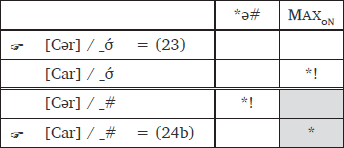
However, and that is where my contribution to this problem lies, constraints alone are not enough, representations matter. As Anderson (1985: 350) had observed, phonology requires both computation and representation. The representations provided by the AT explain why only /Vr/-rhymes are subject to this variation, by showing that only in /Vr/-rhymes can N1 associate sometimes to one position (23), sometimes to two positions (24b). This cannot be done in a non-arbitrary way if we place the burden of explanation entirely on phonological computation, as most applications of OT do. The overall picture points to complementarity. Representations determine where computation occurs: /Vr/. Computation determines the result via constraint ranking: had *ə# been lower ranked than MaxoN (causing no N-delinking), final /Vr/ would have undergone vowel reduction, as it does in some non-standard varieties.
6 Concluding on weight and length
In sum, EP /Vr/-rhymes have two representations: the vowel in word-internal structures like (26a) is light because it has only one N-x link, while it is heavy in word-final structures like (26b) as it has two such links.
- (26)
Assuming that weight is based on N-association, the unmarked stress pattern of Portuguese (cf. Section 2) can be said to have the four realizations in (27) that include the problematic vowel-final oxytones, which should be rendered as in (27c).
- (27)
Note that the structure in (27c), like those in (27a,b,d), is not restricted to word-final position. EP shows several cases of word-internal monophthongs that escape vowel reduction in pretonic position seen in (6): cf., for example, pr[ɛ]go ~ pr[ɛ]gar ‘preach1sg.pres~inf’, g[a]nho ~ g[a]nhar ‘win1sg.pres~inf’, c[ɔ]ro ~ c[ɔ]rar ‘blush1sg.pres~inf’.7 Such monophthongs contrast with the (much more numerous) vowels that undergo reduction, and as such imply a monopositional nucleus: cf., e.g., pr[ɛ]go ~ pr[ə]gar ‘nail1sg.pres~inf’, b[a]to ~ b[ɐ]ter ‘hit1sg.pres~inf’, m[ɔ]ro ~ m[u]rar ‘live in1sg.pres~inf’.
The structures under (27b) and (27d) also underly nasal monophthongs (e.g. [sı̃] sim ‘yes’, [bõ] bom ‘good’, [ɐˈtũ] atum ‘tuna’, [rɐ̃] rã ‘frog’) and diphthongs (e.g. [mɐ̃ɪ̯̃] mãe ‘mother’, [pɐ̃ɪ̯̃] pão ‘bread’, [vẽɪ̯̃] or [vɐ̃ɪ̯̃] vem ‘come3sg.pres’, [põɪ̯̃] põe ‘put3sg.pres’) respectively, where the nasal melody is linked to the single V in the former and to the two Vs in the latter. Nasal monophthongs differ from diphthongs in that they behave differently. As shown in (28), since they involve an empty onset (O2) in the C-plane, monophthongs allow place (Pl) spreading, hence homorganic clusters as in campo, canto, banco etc. Also, since there is a governed empty nucleus (n2), O3 is in strong position, hence rhotic fortition (/r/ → [r] or [ʁ], instead of [ɾ]) in honra ‘honour’, genro ‘son-in-law’ etc., like in melro ‘blackbird’, guelra ‘gills’, but not with diphthongs (cf. bairro ‘neighbourhood’ vs. Cairo); indeed, nasal monophthongs and /Vl/-rhymes involve the very same structure.
- (28)
In (27a–d), stress placement by default is determined by the penultimate N-x link. For comparison, (29) represents /Vs/-rhymes, which are light as they involve only one N-x link.
- (29)
Also, (27b,c,d) escape vowel reduction if unstressed due to Honeybone’s (2005) principle according to which “sharing makes us stronger”. In all these structures, including diphthongs (cf. Caratini 2009: 478–489), the two N-x links allow melodic sharing, insofar as at least part of the vowel elements are ultimately shared by two skeletal slots.8
But what about length? Had long vowels existed in Portuguese, they would display the same structure as the (heavy) diphthongs under (27d), the only difference being that the two nuclei share the same melodic content (V), as shown in (30).
- (30)
Note that the same distinction as between (27c) and (30) can be argued to exist for consonants as well. Although this requires further research, it seems that there are two types of “fortis” consonants, which might be illustrated by Swiss German and Korean respectively: cf. (15e) and (16e) in Section 4. Both types differ from geminates: the former are tautosyllabic, and only geminates, which do not involve a C/V gap as shown in (19b), may be moraic.
One last point before concluding. It seems that (short) heavy vowels are much rarer than long vowels. The question therefore arises whether their rarity – or markedness – is reflected in their representation. I think it is, although, here again, this point needs further research. Among the “C/V gaps” where the C-plane is longer than the V-plane seen in Section 4, (15f) (= 27c) is the only structure that shows only one filled position in the C-plane. By contrast, (16f) (= 27d, 30), which allows diphthongs and long vowels, has two filled positions in the V-plane. Markedness might thus be related to what could be termed as “low density” of representations: structures with only two filled O/N positions for three slots, as in (27c), appear as more costly than those with three filled O/N positions for three slots, as in (27d, 30). Note that this is perfectly consistent with the Strict CV model, where closed syllables and syllables without onset are marked in that they involve empty positions: CVC. and .V respectively.
In conclusion, I would like to emphasize three important achievements of AT. They stand out particularly when compared to an alternative solution that has been around for a long time: the device of “virtual length”, where a vowel/consonant is structurally long but one of its CV-units (or x-slots) is not phonetically interpreted (see e.g. Lowenstamm 1996). Can EP short heavy vowels be represented as virtually long? Yes, certainly, but why distinguish between two types of length? By contrast, as can be seen by comparing (27c) to (30), the explanation provided here succeeds in disentangling vowel weight from timing while unifying the contributions of moraic phonology and of the theories of the x-skeleton from the 1980s.
Secondly, as can also be seen by comparing (27c) to (30), a typologically interesting outcome of such representations is that, whereas long vowels are bimoraic, the reverse is not true, as in the case of Portuguese, where heavy vowels are not long.
Thirdly, as shown under (30), and in accordance with what I have said in Section 2, weight and length pertain to different facets of phonological representations: whereas (syllable) weight is based on the number of N-x links, (vowel) length depends on the number of V-N associations; in other words, while weight (like sonority) is structure-based, length (like diphthongs) is a matter of melody.
Notes
- Also neither the palatal sonorants [ɲ] (nh) and [ʎ] (lh), nor the “strong” rhotic [r, ʁ] (rr) can occur in this context. In line with the WBT, this has been explained by assuming that these consonants involve either underlying geminates (Giangola 1995; Wetzels 1997: 220), or, for [ɲ, ʎ], a preceding diphthong (Pimenta 2019: 220–222). [^]
- There is at least one point of similarity between AT and Van der Hulst’s (2020) Radical CV Phonology (RCVP). In both theories, C and V (here O and N), which are commonly assigned a purely positional rather than a melodic value, can occur in different contexts, thereby receiving a different phonetic interpretation. However, unlike RCVP, AT is not a global theory of phonological primes. Like Pöchtrager’s (2006) GP 2.0, albeit quite differently, its primary aim is to show that sonority-related features are structure, and how such a view accounts for syllable structure and phonotactic constraints (cf. Carvalho 2017). [^]
- The assumption that T, S and R result from O-o, n-o and O-N alignments respectively is based on the hypothesis that the O1n1O2n2 sequence where O1 and n2 on the C-plane are aligned with o and N on the V-plane reflects the classic sonority scale from plosives to vowels illustrated by clusters as those found in German Pflege ‘care’ or Pflicht ‘duty’, with affricates in TR onsets. [^]
- “Harmonic cluster” is the term that is often used to refer to Georgian sequences of two plosives of a similar type (voiced, aspirated, or ejective) which are pronounced with only a single release, and whose second element is dorsal. See on this topic Chitoran (1998). [^]
- Note that this may indeed occur in such frequent phrases as toma(r) café ‘have a cup of coffee’. [^]
- As a result of this process, /Vr/ in (24b) and /Vl/ in (22b) have identical representations. However, /r/ and /l/ are supposed to differ from each other melodically as well. I will not dwell into details on that difference, as it is irrelevant for the present topic. It turns out that Portuguese processes the two liquids differently and in this way, but nothing in the theory prevents an identical or an opposite behaviour of /Vr/ and /Vl/ elsewhere. [^]
- Some of these vowels come from the so-called Galician-Portuguese “hiatuses” that were monophthongized during the XIVth c.: GP preegar < Lat. praedicare, gaanhar < *gwadaniare, coorar < colorare. Others come from the loss of plosive codas in learned words: cf. conc[ɛ](p)ção ‘conception’, [a](c)ção ‘action’, ad[ɔ](p)tar ‘adopt’. [^]
- This also applies to diphthongs like /ai/ and /au/, which are actually pronounced as [ae̯] and [ao̯] by virtue of A propagation: see Caratini (2009: 484) and references therein. [^]
Acknowledgements
I wish to thank Heglyn Leite Pimenta, whose dissertation supervision has been extremely useful to me in reflecting on the themes addressed here, and two anonymous reviewers for their valuable contribution to the final version of this article.
Competing Interests
The author has no competing interests to declare.
References
Ahn, Sang-Cheol & Iverson, Gregory K. 2004. Dimensions in Korean Laryngeal Phonology. Journal of East Asian Linguistics, 13(4). 345–79. DOI: http://doi.org/10.1007/s10831-004-4256-x
Anderson, Stephen R. 1985. Phonology in the twentieth century. Chicago & London: The University of Chicago Press.
Caratini, Emilie. 2009. Vowel and consonantal quantity in German: synchronic and diachronic perspectives: Université de Nice, Universität Leipzig dissertation.
Carvalho, Joaquim Brandão de. 1989. Phonological conditions on Portuguese clitic placement: on syntactic evidence for stress and rhythmical patterns. Linguistics 27. 405–436. DOI: http://doi.org/10.1515/ling.1989.27.3.405
Carvalho, Joaquim Brandão de. 2003. Templatic morphology in the Portuguese verb. In Meisenburg, Trudel & Selig, Maria (eds.), Nouveaux départs en phonologie: les conceptions sub- et suprasegmentales, 13–32. Tübingen: Gunter Narr Verlag.
Carvalho, Joaquim Brandão de. 2015. Accent et verbe en ibéro-roman: Une conception néo-néogrammairienne de l‘interaction phono-/morphologie [Stress and verb in Ibero-Romance: A neo-neogrammarian approach to the phonology/morphology interaction]. Paper presented at the 13th Réseau Français de Phonologie (RFP) Meeting, Bordeaux, 2015.
Carvalho, Joaquim Brandão de. 2017. Deriving sonority from the structure, not the other way round: A Strict CV approach to consonant clusters. The Linguistic Review 34. 589–614. DOI: http://doi.org/10.1515/tlr-2017-0012
Carvalho, Joaquim Brandão de. 2022. -s e -z em português: segmento idêntico mas estrutura diferente. [-s and -z in Portuguese: same segment, different structure]. Letrônica 29 (1). DOI: http://doi.org/10.15448/1984-4301.2022.1.42587
Chitoran, Ioana. 1998. Georgian harmonic clusters: phonetic cues to phonological representation. Phonology 15. 121–141. DOI: http://doi.org/10.1017/S0952675798003558
Fujimura, Osamu. 1992. Phonology and phonetics: A syllable-based model of articulatory organization. Journal of the Acoustical Society of Japan 13. 39–48. DOI: http://doi.org/10.1250/ast.13.39
Garcia, Guilherme D. 2017. Weight gradience and stress in Portuguese. Phonology 34. 41–79. DOI: http://doi.org/10.1017/S0952675717000033
Garcia, Guilherme D. 2019. When lexical statistics and the grammar conflict: Learning and repairing weight effects on stress. Language 95. 612–641. DOI: http://doi.org/10.1353/lan.2019.0068
Garcia, Guilherme D. & Goad, Heather. 2021, April 5. Weight effects and the parametrization of the foot: English vs. Portuguese. Ms. DOI: http://doi.org/10.31219/osf.io/pc6hg
Giangola, James P. 1995. Complex palatal geminates in Brazilian Portuguese. In Aranovich, Raul & Byrne, William & Preuss, Susanne & Senturia, Martha (eds.), Proceedings of the Thirteenth West Coast Conference on Formal Linguistics, 46–61. Chicago: University of Chicago Press.
Honeybone, Patrick. 2005. Sharing makes us stronger: Process inhibition and segmental structure. In Carr, Philip & Durand, Jacques & Ewen, Colin J. (eds.), Headhood, elements, specification and contrastivity, 167–192. Amsterdam: Benjamins. DOI: http://doi.org/10.1075/cilt.259.12hon
Hyman, Larry M. 1985. A theory of phonological weight. Dordrecht: Foris. DOI: http://doi.org/10.1515/9783110854794
Kaye, Jonathan & Lowenstamm, Jean & Vergnaud, Jean-Roger. 1990. Constituent structure and government in phonology. Phonology 7. 193–231. DOI: http://doi.org/10.1017/S0952675700001184
Kraehenmann, Astrid. 2001. Swiss German stops: geminates all over the word. Phonology 18. 109–145. DOI: http://doi.org/10.1017/S0952675701004031
Levin, Juliette. 1983. Dependent levels of representation: the skeletal tier and syllabic projections. Paper presented at the 8th GLOW Meeting, York, 1983.
Lowenstamm, Jean. 1996. CV as the only syllable type. In Durand, Jacques & Laks, Bernard (eds.), Current trends in phonology: models and methods, vol. 2, 419–441. Salford: European Studies Research Institute.
Lüdtke, Helmut. 1953. Fonemática portuguesa. II: Vocalismo [Portuguese phonemics. II. Vowels]. Boletim de filologia 14. 218–232.
Macken, Marlys A. 1992. Where’s phonology? In Ferguson, Charles A. & Menn, Lise & Stoel-Gammon, Carol (eds.), Phonological development: Models, research, implications, 249–269. Timonium, Maryland: York Press.
Mateus, Maria Helena Mira. 1982. Aspectos da fonologia portuguesa [Aspects of Portuguese phonology]. Lisboa: Instituto Nacional de Investigação Científica.
Mateus, Maria Helena Mira & d’Andrade, Ernesto. 2000. The Phonology of Portuguese. Oxford: Oxford University Press.
McDonough, Joyce & Myers, Scott. 1991. Consonant harmony and planar segregation in child language. Manuscript. Austin: UCLA and University of Texas.
Obleser, Jonas & Leaver, Amber M. & VanMeter, John & Rauschecker, Josef P. 2010. Segregation of vowels and consonants in human auditory cortex: evidence for distributed hierarchical organization. Frontiers in Psychology 1. Article 232. DOI: http://doi.org/10.3389/fpsyg.2010.00232
Öhman, Sven Erik Gustav. 1966. Coarticulation in VCV utterances: Spectrographic measurements. Journal of the Acoustical Society of America 39. 151–68. DOI: http://doi.org/10.1121/1.1909864
Pereira, Maria Isabel. 1999. O acento de palavra em português: uma análise métrica [Word stress in Portuguese: A metrical analysis]: University of Coimbra dissertation.
Pereira, Maria Isabel. 2007. Acento latino e acento em português. Que parentesco? [Latin stress and Portuguese stress. What do they have in common?]. In Araujo, Gabriel Antunes de (ed.), O acento em Português: Abordagens fonológicas, 61–83. São Paulo: Parábola.
Pimenta, Heglyn. 2019. Nasalité et syllabe: Une étude synchronique, diachronique et dialectologique du portugais européen [Nasality and syllable: A synchronic, diachronic and dialectological study of European Portuguese]: University of Paris 8 dissertation.
Pöchtrager, Markus. 2006. The Structure of Length: University of Vienna, dissertation.
Rosenthall, Sam & Van der Hulst, Harry. 1999. Weight-by-position by position. Natural Language and Linguistic Theory 17. 499–540. DOI: http://doi.org/10.1023/A:1006283229291
Scheer, Tobias. 2004. A lateral theory of phonology: What is CVCV, and why should it be? Berlin: Mouton de Gruyter. DOI: http://doi.org/10.1515/9783110908336
Topintzi, Nina. 2010. Onsets: Suprasegmental and prosodic behaviour. Cambridge: Cambridge University Press. DOI: http://doi.org/10.1017/CBO9780511750700
Van der Hulst, Harry. 2020. Principles of Radical CV Phonology. Edinburgh: Edinburgh University Press. DOI: http://doi.org/10.3366/edinburgh/9781474454667.001.0001
Vergnaud, Jean-Roger. 1982. On the theoretical bases of phonology. Paper presented at the 7th GLOW Meeting, Paris, 1982.
Viaro, Mário Eduardo & Guimarães-Filho, Zwinglio O. 2007. Análise quantitativa da freqüência dos fonemas e estruturas silábicas portuguesas [Quantitative analysis of phoneme and syllable structure frequency in Portuguese]. Estudos Lingüísticos 36 (1). 27–36.
Vigário, Marina. 2003. The prosodic word in European Portuguese. Berlin: Mouton de Gruyter. DOI: http://doi.org/10.1515/9783110900927
Wetzels, W. Leo. 1997. The lexical representation of nasality in Brazilian Portuguese. Probus 9(2). 203–232. DOI: http://doi.org/10.1515/prbs.1997.9.2.203
Wetzels, W. Leo. 2007. Primary stress in Brazilian Portuguese and the quantity parameter. Journal of Portuguese Linguistics 5/6. 9–58. DOI: http://doi.org/10.5334/jpl.144


